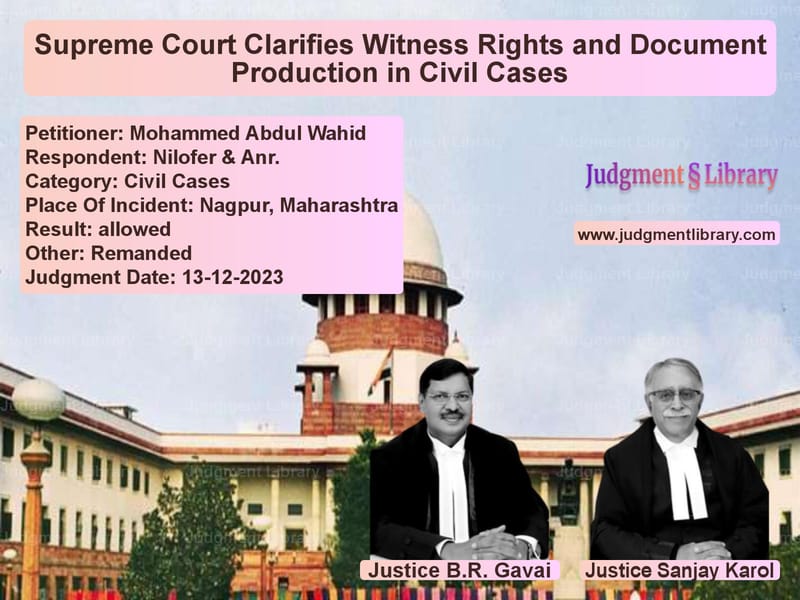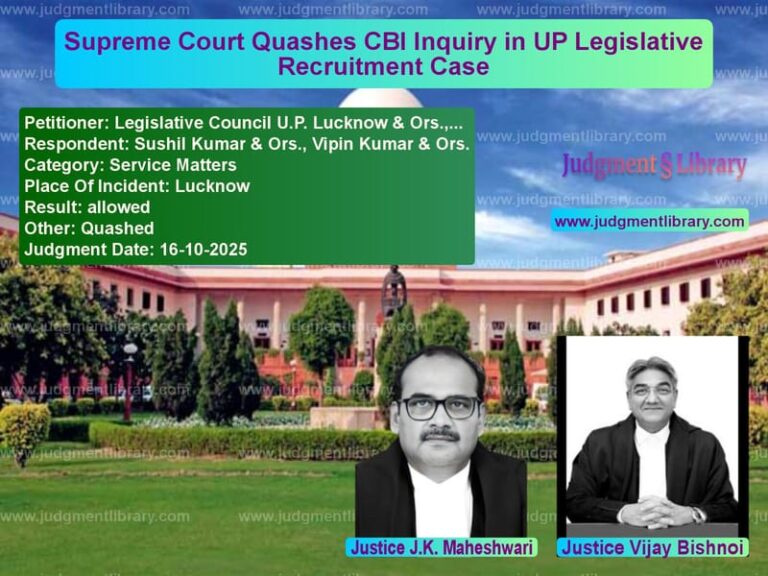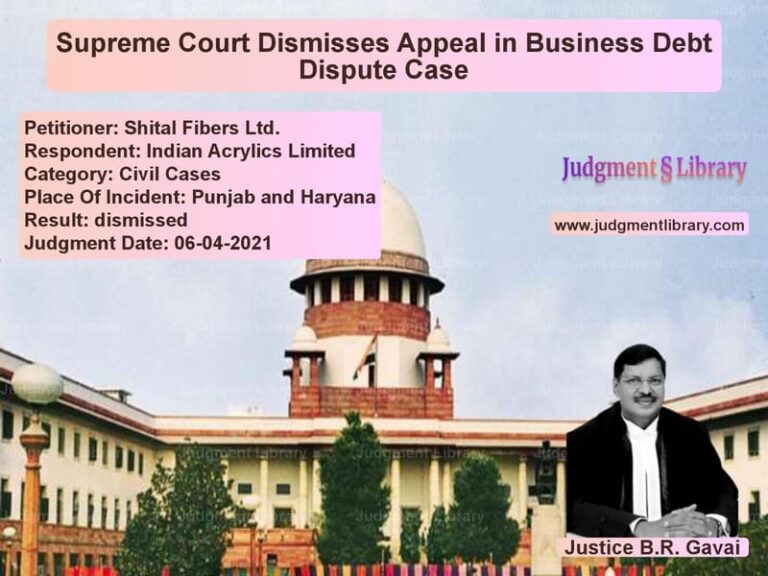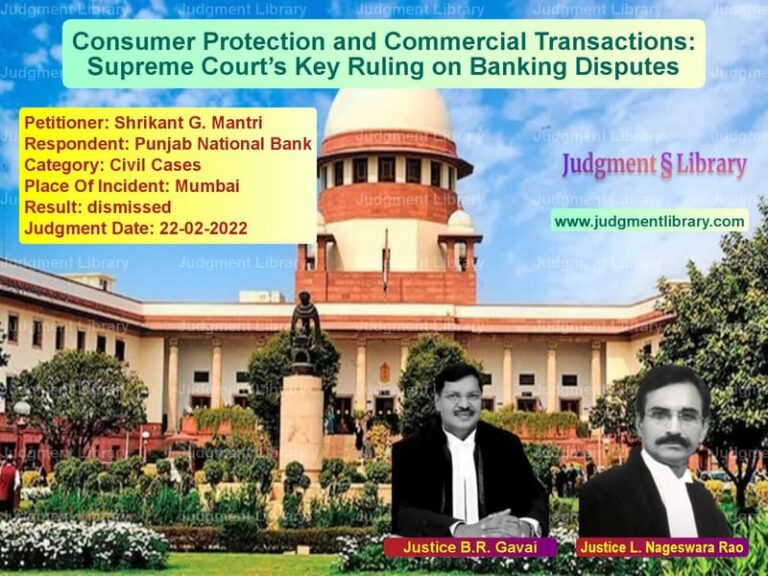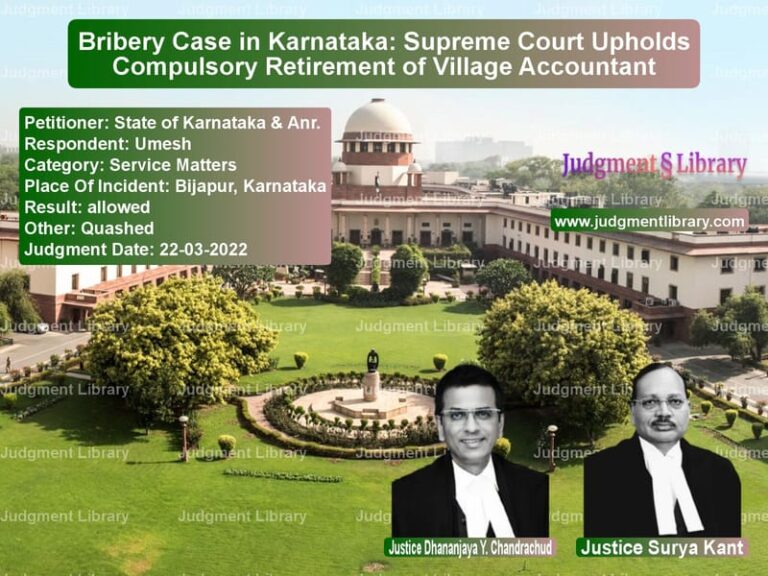Supreme Court Clarifies Witness Rights and Document Production in Civil Cases
The case of Mohammed Abdul Wahid v. Nilofer & Anr. is a landmark ruling by the Supreme Court of India addressing key procedural aspects in civil litigation. The Court examined whether a party to a suit can be equated with a witness and whether documents can be directly introduced during cross-examination. This decision resolves a long-standing judicial conflict on these issues.
Background of the Case
The dispute arose from a judgment by the Bombay High Court (Nagpur Bench) in Writ Petition No. 7717/2019 and Writ Petition No. 6931/2019. The High Court examined two conflicting judgments: Vinayak M. Dessai v. Ulhas N. Naik and Purushottam v. Gajanan, which had contradictory interpretations regarding the status of a party as a witness and the admissibility of documents at the cross-examination stage.
Read also: https://judgmentlibrary.com/supreme-court-rules-on-nominee-rights-in-shares-succession-laws-prevail/
The case involved two primary questions:
- Can a plaintiff or defendant be treated as a “witness” under the Code of Civil Procedure (CPC)?
- Can documents be introduced directly during the cross-examination stage?
Legal Issues Raised
- Whether a party to a suit (plaintiff/defendant) is also a witness under the CPC.
- Whether documents can be introduced during cross-examination without prior submission.
- Whether the Bombay High Court correctly interpreted the CPC provisions.
Arguments of the Appellant
The appellant’s counsel, Mr. Huzefa Ahmadi, contended:
- The High Court erred in distinguishing between a party and a witness.
- Sections 120 and 137 of the Indian Evidence Act, 1872 do not make such a distinction.
- Order VII Rule 14(4), Order VIII Rule 1-A(4), and Order XIII Rule 1(3) CPC allow production of documents during cross-examination.
- Preventing parties from confronting witnesses with documents would undermine the integrity of cross-examinations.
Arguments of the Respondents
The respondents, represented by Dr. R.S. Sundaram, countered:
- “Plaintiff’s witnesses” and “Defendant’s witnesses” exclude the parties to the suit.
- Surprise introduction of documents during cross-examination should not be permitted.
- The CPC provisions regulate how and when documents can be introduced.
- Producing new documents during cross-examination would undermine procedural fairness.
Supreme Court’s Observations
1. A Party to a Suit Is Also a Witness
The Court ruled that a plaintiff or defendant, when testifying, assumes the same role as a witness:
“It is clear that witnesses and parties to a suit, for the purposes of adducing evidence, either documentary or oral, are on the same footing.”
2. Documents Can Be Introduced During Cross-Examination
The Court held that documents can be produced for cross-examination, provided they are relevant to the case. The ruling clarified:
“The freedom to produce documents for either of the two purposes—cross-examination of witnesses and refreshing the memory—serves its purpose for parties to the suit as well.”
3. Overruling the High Court’s Interpretation
The Supreme Court found the High Court’s distinction between a party and a witness to be flawed. It held that:
- The Evidence Act and CPC do not differentiate between a party and a witness.
- The right to cross-examine must not be undermined by procedural barriers.
- The ability to introduce documents is essential for fair trial procedures.
Final Judgment
The Supreme Court ruled:
- The Bombay High Court’s judgment was set aside.
- The case was remanded to the High Court for fresh consideration.
- It was clarified that plaintiffs and defendants are “witnesses” for procedural purposes.
- The introduction of documents during cross-examination is permissible.
The Court concluded:
“The distinction created by the High Court does not serve any purpose of law. A plaintiff or a defendant at their own behest may enter evidence in court, and they must have the same rights as other witnesses.”
Key Takeaways
1. Parties Are Witnesses Under Civil Procedure Rules
When a plaintiff or defendant testifies, they are subject to the same rules as other witnesses.
2. Cross-Examination Can Include New Documents
Documents can be introduced during cross-examination to test credibility.
3. Fair Trial Standards Reinforced
The judgment ensures that procedural rules do not obstruct the discovery of truth.
4. High Court’s Interpretation Overturned
The Supreme Court clarified that parties can introduce documents to confront witnesses.
Conclusion
The Supreme Court’s ruling settles a critical legal question in civil procedure. It ensures that plaintiffs and defendants are treated as witnesses and can introduce documents during cross-examination. This decision strengthens procedural fairness and reinforces the right to a comprehensive defense in civil litigation.
Read also: https://judgmentlibrary.com/supreme-court-remands-land-fragmentation-case-for-fresh-consideration/
Petitioner Name: Mohammed Abdul Wahid.Respondent Name: Nilofer & Anr..Judgment By: Justice B.R. Gavai, Justice Sanjay Karol.Place Of Incident: Nagpur, Maharashtra.Judgment Date: 13-12-2023.
Don’t miss out on the full details! Download the complete judgment in PDF format below and gain valuable insights instantly!
Download Judgment: mohammed-abdul-wahid-vs-nilofer-&-anr.-supreme-court-of-india-judgment-dated-13-12-2023.pdf
Directly Download Judgment: Directly download this Judgment
See all petitions in Contract Disputes
See all petitions in Property Disputes
See all petitions in Judgment by B R Gavai
See all petitions in Judgment by Sanjay Karol
See all petitions in allowed
See all petitions in Remanded
See all petitions in supreme court of India judgments December 2023
See all petitions in 2023 judgments
See all posts in Civil Cases Category
See all allowed petitions in Civil Cases Category
See all Dismissed petitions in Civil Cases Category
See all partially allowed petitions in Civil Cases Category

